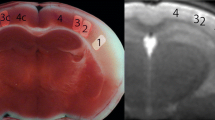Abstract
A newly-developed model of transient global ischemia in the rat was evaluated by magnetic resonance imaging (MRI) in terms of localization of brain lesions, their extent and severity, and temporal evolution. Such a model, consisting of bilateral occlusion of common carotid arteries for 10 minutes and mild hypoxia (15% O2) for 20 minutes induces delayed neuronal degeneration, necrosis, and gliosis (detected histologically and immunohistochemically). Ischemia was assessed by full suppression of spontaneous electroencephalographic activity. A “hybrid” T2-/diffusion-weighted MR sequence enhancing more effectively the contrast between injured and intact tissues as compared to T2-weighted MRI was used at 24, 48, 72, and 96 hours and at 7 days postischemia. Twenty hypoxic-ischemic rats showed a considerable variability in brain damage. In 8, there were no MRI-detectable lesions at any interval. In the other 12 rats, the severity and extension of neuronal damage varied markedly, but the lesions were always localized (monolaterally in 8 and bilaterally in 4 rats) in the occipital, temporal, or parietal cerebral cortex. Mainly, they were of intermediate severity or were severe (as assessed by MRI hyperintensity) and were accompanied by usually less severe lesions in the thalamus and/or caudate putamen. The hippocampus was affected moderately or severely in 4 of 12 rats. In most cases, there was at 48 hours a considerable growth in severity and/or extension of lesions, which usually remained stable at later intervals. In conclusion, MRI allowed us to follow brain lesions during the first week in this relatively simple and noninvasive model of transient global ischemia.
Similar content being viewed by others
References
Karpiak SE, Tagliavia A, Wakade CG (1989) Animal models for the study of drugs in ischemic stroke.Annu Rev Pharmacol Toxicol 29: 403–414.
Ginsberg MD, Busto R (1989) Rodent models of cerebral ischemia.Stroke 20: 1627–1642.
Hossman KA (1991) Animal models of cerebral ischemia. 1. Review of literature.Cerebrovasc Dis 1(Suppl 1): 2–15.
Pulsinelli WA, Brierley JB, Plum F (1982) Temporal profile of neuronal damage in a model of transient forebrain ischemia.Ann Neurol 11: 491–498.
Saunders JK, Smith ICP, MacTavish JC, Rydzy M, Peeling J, Sutherland E, Lesiuk H, Sutherland GR (1989) Forebrain ischemia studied using magnetic resonance imaging and spectroscopy.NMR Biomed 2: 312–316.
Rumpel H, Büchli R, Gehrmann J, Aguzzi A, Illi O, Martin E (1995) Magnetic resonance imaging of brain edema in the neonatal rat: a comparison of short and long-term hypoxia-ischemia.Pediatr Res 38: 113–118
Germano IM, Pitts LH, Berry I, Moseley M (1989) Magnetic resonance imaging and31P magnetic resonance spectroscopy for evaluating focal cerebral ischemia.J Neurosurg 70: 612–618.
Mintorovitch J, Moseley ME, Chileuitt L, Shimizu H, Cohen Y, Weinstein PR (1991) Comparison of diffusion and T2-weighted MRI for the early detection of cerebral ischemia and reperfusion in rats.Magn Reson Med 18: 39–50.
Benveniste H, Hedlund LW, Johnson GA (1992) Mechanism of detection of acute cerebral ischemia in rats by diffusion-weighted magnetic resonance microscopy.Stroke 23: 746–754.
Back T, Hoehn-Berlage M, Kohno K, Hossman KA (1994) Diffusion nuclear magnetic resonance imaging in experimental stroke: correlation with cerebral metabolites.Stroke 25: 494–500.
Gyngell ML, Busch E, Schmitz B, Kohno K, Back T, Hoehn-Berlage M, Hossman KA (1995) Evolution of acute focal cerebral ischemia in rats observed by localised1H MRS, diffusion-weighted MRI, and electrophysiological monitoring.NMR Biomed 8: 206–214.
Hoehn-Berlage M, Eis M, Back T, Kohno K, Yamashita K (1995) Changes of relaxation times (T1, T2) and apparent diffusion coefficient after permanent middle cerebral artery occlusion in the rat: temporal evolution, regional extent and comparison with histology.Magn Reson Med 34: 824–833.
Kohno K, Back T, Hoehn-Berlage M, Hossmann KA (1995) A modified rat model of middle cerebral artery thread occlusion under electrophysiological control for magnetic resonance investigations.Magn Reson Imaging 13: 65–71.
Kohno K, Hoehn-Berlage M, Mies G, Back T, Hossmann KA (1995) Relationship between diffusion-weighted MR images, cerebral blood flow, and energy state in experimental brain infarction.Magn Reson Imaging 13: 73–80.
Herz RCG, Jonker M, Verheul HB, Hillen B, Versteeg DHG, de Wildt DJ (1996) Middle cerebral artery occlusion in Wistar and Fischer 344 rats: functional and morphological assessment of the model.J Cereb Blood Flow Metab 16: 296–302.
Le Bihan D, Breton E, Lallemand D, Grenier P, Cabanis E, Laval-Jeantet M (1986) MR imaging of intravoxel incoherent motions: application to diffusion and perfusion in neurologic disorders.Radiology 161: 401–407.
Peres M, Bourgeois D, Roussel S, Lefur Y, Devoulon P, Remy C, Barrere R, Decorps M, Pinard E, Riche D, Benabid AL, Seylaz J (1992) Two-dimensional1H spectroscopic imaging for evaluating the local metabolic response to focal ischemia in the conscious rat.NMR Biomed 5: 11–19.
Fortuna S, Pestalozza S, Lorenzini P, Bisso GM, Morelli L, Michalek H (1997) Transient global brain ischemiahypoxia in adult rats: neuronal damage, glial proliferation and alterations in inositol phospholipid hydrolysis.Neurochem Int 30 (in press).
Canese R, Fortuna S, Lorenzini P, Podo F, Michalek H (1996) Evaluation of transient global brain hypoxiaischemia (TGBHI) progression in rats by T2 magnetic resonance imaging (MRI) study.MAGMA 6(Suppl 2): 169.
Knight RA, Ordidge RJ, Helpern JA, Chopp M, Rodolosi LC, Peck BS (1991) Temporal evolution of ischemic damage in rat brain measured by proton nuclear magnetic resonance imaging.Stroke 22: 802–808.
Millikan C (1992) Animal stroke models.Stroke 23: 795–797.
Hunter AJ, Green AR, Cross AJ (1995) Animal models of acute ischaemic stroke: can they predict clinically successful neuroprotective drugs?Trends Pharmacol Sci 16: 123–128.
Canese R, Podo F, Lorenzini P, Fortuna S, Michalek H (1997) Transient global brain hypoxia-ischemia in young and aged rats: localisation, extension and progression of lesions by means of magnetic resonance imaging.Proceedings of the Fifth Scientific Meeting of the International Society for Magnetic Resonance in Medicine, p. 590.
Author information
Authors and Affiliations
Rights and permissions
About this article
Cite this article
Canese, R., Podo, F., Lorenzinu, P. et al. Transient global brain ischemia in the rat: spatial distribution, extension, and evolution of lesions evaluated by magnetic resonance imaging. MAGMA 5, 139–149 (1997). https://doi.org/10.1007/BF02592245
Received:
Accepted:
Issue Date:
DOI: https://doi.org/10.1007/BF02592245




